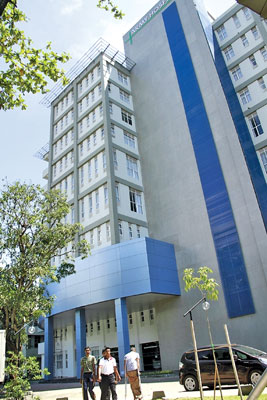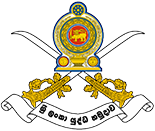 The opening of the largest military hospital in Narahenpita by President Mahinda Rajapaksa today is undoubtedly a boon to thousands of military personnel who made many sacrifices for the sake of the country.
The opening of the largest military hospital in Narahenpita by President Mahinda Rajapaksa today is undoubtedly a boon to thousands of military personnel who made many sacrifices for the sake of the country.A hospital of this sort was a long- felt need for the military personnel who became disabled in many missions aimed at wiping out terrorism which plagued the country for more than 3 decades.
The service personnel who sacrificed their limbs or otherwise injured for the protection of country's sovereignty and territorial integrity will receive priority service at this hospital. Facilities are available at this hospital to conduct most intricate and subtle surgeries for this war heroes who deserve the honour of all Sri Lankans.
This new hospital is a testimony to the government's dedication and commitment to ensure the well being of the Security Forces personnel,ex-servicemen and their family members. A special feature of the hospital is that it has a ward complex dedicated for the service of ex - servicemen and their family members
The Sri Lanka Army had only two hospitals in the Colombo region which could cater to only 300 personnel at any given time. In contrast, the new hospital opened today can accommodate 1000 personnel and their family members at any given time at the Outdoor Patient Department while 1024 can receive indoor treatment.
Dedication
This hospital is also open for the members of Sri Lanka Navy and the Sri Lanka Air force too. President Mahinda Rajapaksa having understood the need for a fully fledged hospital for the military personnel, particularly the disabled, allocated Rs. 4 billion for this project while Defence Secretary Gotabhaya Rajapaksa took the project forward by providing military equipment worth Rs. 2 billion.
The staff for the hospital has already been recruited and they are receiving comprehensive training in their particular field. The Sri Lanka Army recruited 800 nurses for this hospital two years back and they are to be deployed to the new military hospital soon.
A part of these nurses will also be deployed to the teaching hospital which is being constructed in Werahera in affiliation to the Kotelawala Defence University.
The hospital will also obtain the services of medical officers who have already in the volunteer force in addition to the medical officers and the specialists of the Regular forces of the Sri Lanka Army.
Medical officers in the civil society have been providing their service to the sri Lanka Army and their services will be received to this hospital too. Facilities have been provided in this hospital for the consultants to conduct their clinics too.
The Government has always taken steps to uplift the healthcare of the service personnel. Medical facilities were uplifted in every hospital dedicated for service personnel in various parts of the country.
A Centre
This hospital will become the central wing to peripheral army medical units for reference. This 10 storied hospital complex consists 12 dental units, surgical theatres, MRI scanning , modular operation theatres, Pathology Laboratory, radiology Unit, Dermatology Unit, medical air and Nurses calling facilities, labour room , canteen and auditorium with 314 seats for lectures.
The construction of this hospital was entirely carried out by the Engineering Services Regiment of the Sri Lanka Army. Funds for the purchase of drugs and medical equipment of military hospitals were allocated by the Ministry of Defence.
The history of Sri Lanka Army's medical facilities goes to the year of 1881 when eight medical students of Ceylon (Volunteer) Infantry founded the medical service as stretcher carriers which later took root as an independent Volunteer Medical Force in 1911.
However it was renamed in 1918 as Ceylon Army Volunteer Medical Corps. On 21 October 1949, under the command of Major H.C Serasinghe, Ceylon Army Regular Medical Corps was founded. Thus the regular Medical Corps maintained its 10 bed mini hospital inside the Army Headquarters.
All units other than surgical wards, including the OPD were shifted to the former Sri Lanka Corps of Military Police premises in 2006 following the bomb blast at the army headquarters. Afterwards, the ICU, Dialysis Unit, 5 operation theatres were shifted and accommodated in a three-storied new building at the said premises with 196 beds for resident patients in 2009.
(Courtesy :- Daily News)

